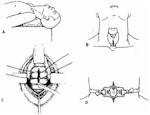Emergency War Surgery NATO Handbook: Part IV: Regional Wounds and Injuries: Chapter XXVII: Wounds and Injuries of the Neck
Emergency Tracheostomy
United States Department of Defense
Tracheostomy as a lifesaving procedure has proven its worth many times over (Figure 32); however, tracheostomy requires a thorough knowledge of anatomy and must be performed many times before it can be done both quickly and safely.
Adequate lighting is essential. Positioning is also very important in tracheostomy. The patient lies supine, with the shoulders elevated by sandbags or folded towels, so that the neck is extended. Local anesthesia is usually utilized. The incision may be longitudinal or transverse. The transverse incision will insure a better cosmetic result, but the longitudinal incision is almost bloodless and there is more rapid exposure of the trachea with it. It is made in the midline, through the skin and platysma, from the cricoid cartilage to the suprasternal notch. The strap muscles are separated in the midline by blunt dissection. When they are retracted, the trachea is exposed. If the isthmus of the thyroid is encountered. it is displaced upward or downward. Local anesthesia, in the amount of 1-2 cc, is injected into the tracheal lumen to reduce the cough reflex. The pretracheal fascia is incised and stripped laterally as necessary to expose the underlying cartilages.
The ideal level at which to incise the trachea is at the level of the second, third, and fourth tracheal rings. The trachea is retracted with a hook between the cricoid and first ring while a vertical incision is made through three tracheal rings. The incision should be made long enough to accommodate the diameter of the tube to be inserted. A heavy silk suture, passed through each side of the incised trachea, may later be used as a retractor and guide to facilitate early tracheostomy tube changes. The adult male trachea can easily accommodate a size 6-9 tracheostomy tube. Smaller tubes cause airway resistance and can lead to hypoxia. Position and secure the tube. The skin incision does not require closure.
Suction should be available at operation to remove secretions from the trachea. If it is not available, the head should be lowered as soon as the trachea has been opened.
Complications associated with tracheostomy are more frequent than realized and should be mentioned:
- Asphyxia from dislodged or occluded tubes.
- Immediate or delayed severe hemorrhage from innominate, subclavian, and carotid vessels.
- Subcutaneous emphysema with possible pneumomediastinum or pneumothorax.
- Tracheoesophageal fistula.
- Tracheal and laryngeal stenosis.
